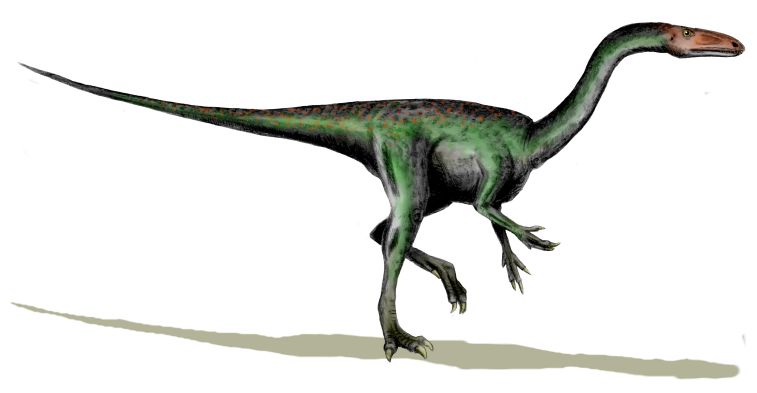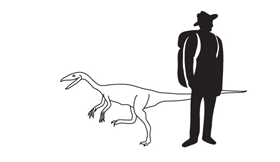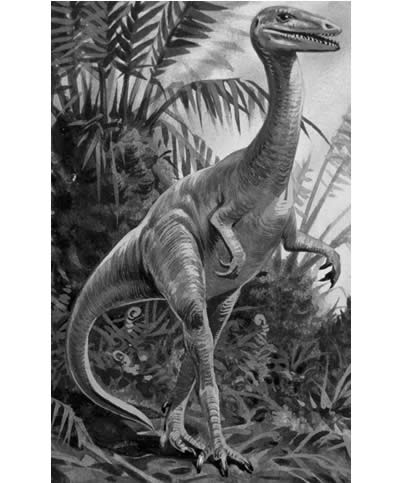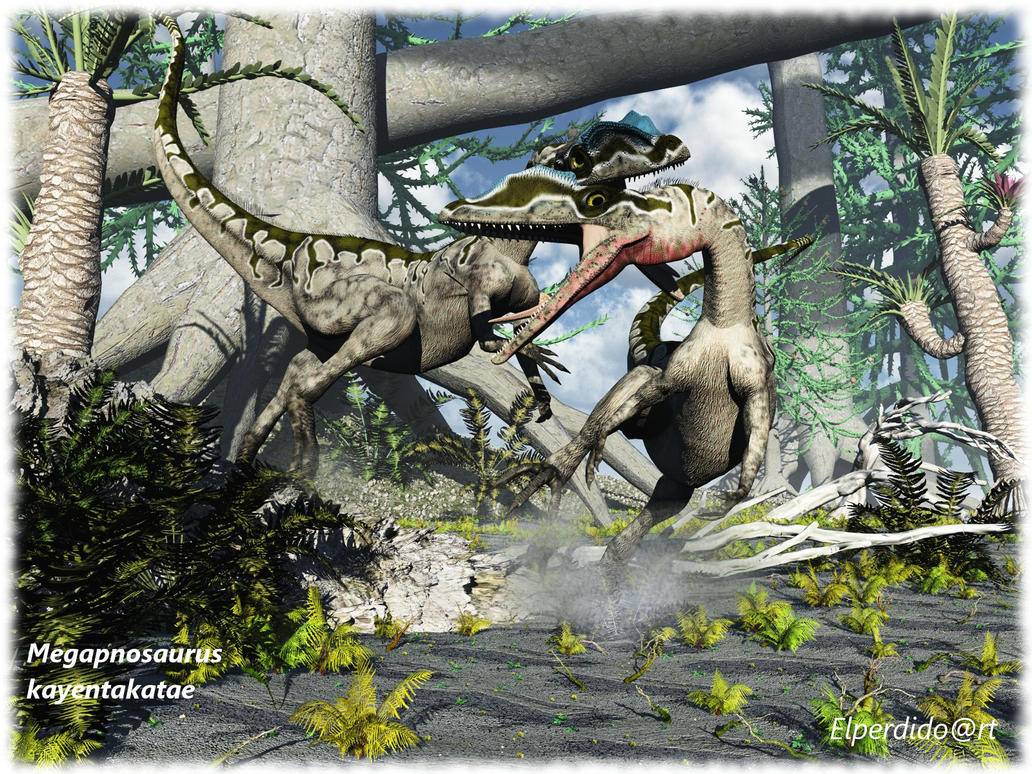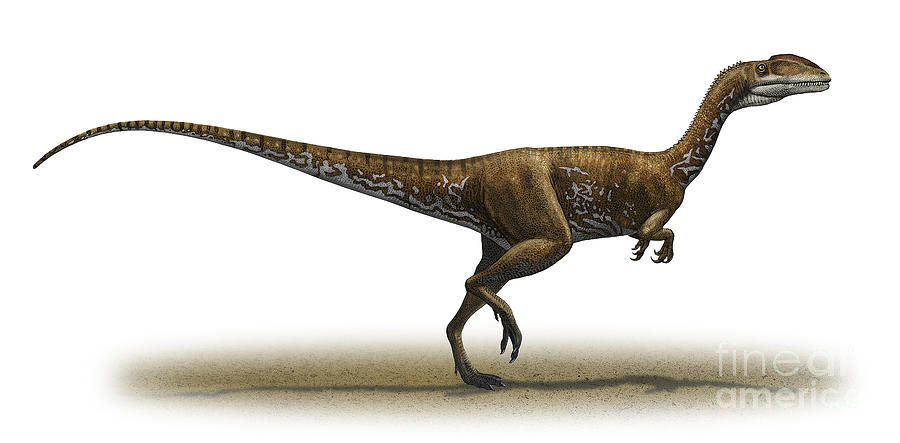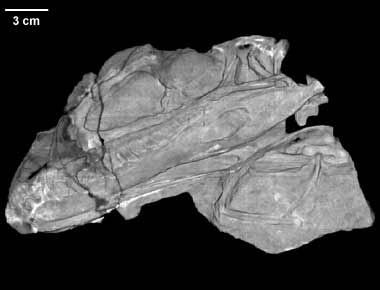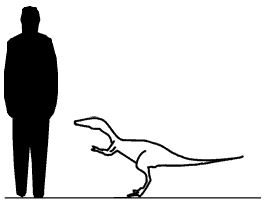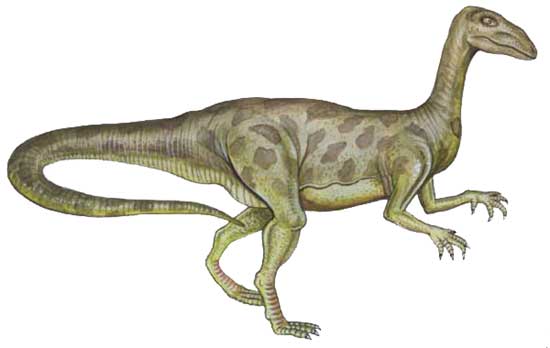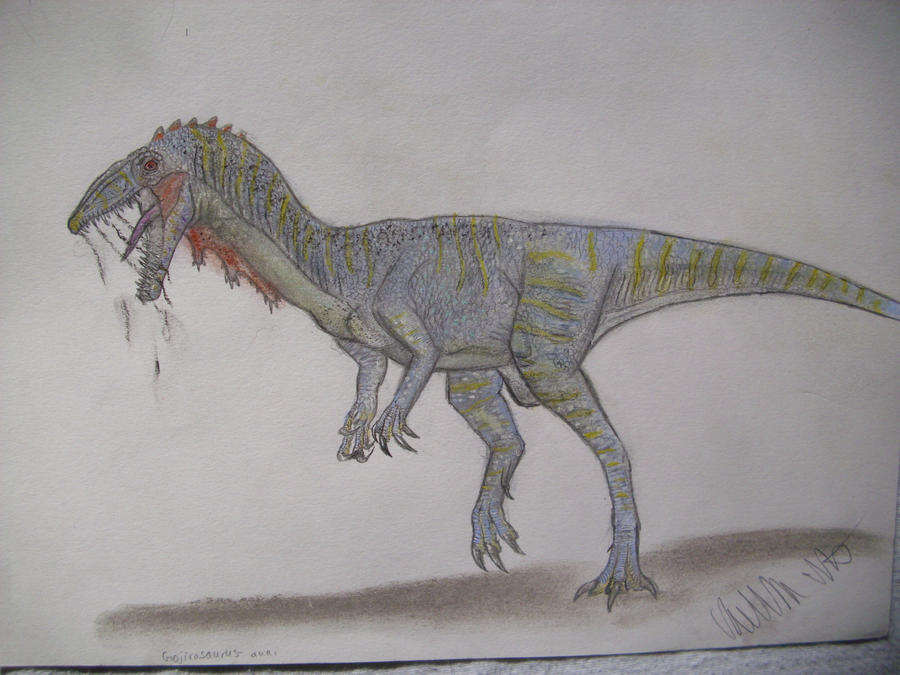[Recent Entries][Archive][Friends][User Info]
Below are the 8 most recent journal entries recorded in the "Сообщество, посвящённое ра" journal:| December 28th, 2012 | |
|---|---|
| 08:11 pm [industrialterro] [Link] |
Segisaurus Segisaurus (meaning "Segi canyon lizard") is a genus of small coelophysoid theropod dinosaur, that measured approximately 1 metre (3 feet) in length. The only known specimen was discovered in 1933 in early Jurassic strata in Tsegi Canyon, Arizona, for which it was named. Segisaurus is the only dinosaur to have ever been excavated from the area. It was later described in 1936 by the paleontologist Charles Lewis Camp. The fragmentary fossil skeleton consisted of portions of the limbs, pelvis, and vertebrae, but no cranial material was located. Segisaurus appears to have been closely related to the better-known Coelophysis. One distinction, however, was that Segisaurus had solid bones, while those of Coelophysis' were hollow. This even made some scientists consider if Segisaurus was even a theropod at all. Later investigations into the specimen in 2005 showed that Segisaurus did in fact have hollow bones, and lead scientists to believe that Segisaurus was related more closely to Procompsognathus. Segisaurus lived about 183 million years ago during the Jurassic period. Segisaurus was roughly the size of a goose and was a primitive bipedal theropod. Segisaurus was roughly 1 metre (3 feet) long, half a metre (1.5 feet) tall and weighed about 4-7 kilograms. It was nimble and insectivorous, although it may have scavenged meat also. It was bird-like in structure, with a flexible, elongated neck and stout body. Segisaurus was three-toed and had powerful legs that were long compared to its body length. Like its legs, Segisaurus had a long tail and long forearms. Its collar bone was not unlike a bird's, thus strengthening scientists' arguments that dinosaurs were related to avians. Segisaurus is described from the only specimen ever found. The holotype, however, was a sub-adult, so that the full size of Segisaurus as an adult may never be known. Strangely, clavicles were found on the Segisaurus specimen, which were unknown in other dinosaurs from that era. The first discovery of Segisaurus was by Max Littlesalt, a Navajo Indian who kept livestock inside Tsegi Canyon. After discovering the remains in the Navajo Sandstone formation of Arizona, Littlesalt pointed out the fossils to archeologists on an expedition inside the canyon. Other than the first finding of Segisaurus, no other specimens have been discovered. After its initial description by Charles Lewis Camp, the holotype went relatively ignored for the next half century. When the specimen was investigated during this period, all who viewed it commented on the presence of clavicles and the solid bone structures the dinosaur had. According to recent reports, Segisaurus is vital in understanding the evolution of early theropods. When the specimen of Segisaurus was discovered, Camp likened it to that of a "sitting hen", due to the position the dinosaur's remains were in. Other theropods used this positions to sleep or stay sheltered during sand and ash storms, and indeed the Segisaurus holotype was found in a bed of sand stone, suggesting that the dinosaur had been submerged in a layer of sand and died. This is still only a hypothesis, as no nest or den materials were discovered along the Segisaurus specimen. Another speculative interpretation from Camp has attracted less attention: that the "splint-like" neck ribs supported a Draco-like patagium along the neck, to improve the animal's ability to move quickly.
In September 2005, the Journal of Vertebrate Paleontology published a report which re-examined the remains of the Segisaurus holotype. The authors concluded, that although very unusual, Segisaurus was firmly a coelophysoid. They also noted that Segisaurus was probably a relative of Procompsognathus. Легкое и проворное животное (примерно 1-1,5 м длиной и 5 кг весом) с длинными задними лапами. Возможно, у него имелись ключицы, наподобие вилочковой кости у птиц. Шея довольно длинная. Долгое время этот вид выделяли в отдельное семейство Segisauridae, на том основании, что некоторые из его длинных костей не являются полыми (что для теропод, особенно мелких, является уникальным, ранее не встречавшимся фактом). Кроме того, в течение долгого времени, этот вид стоял особняком ввиду того, что был одним из немногих тероподов, у которых были найдены хорошо сохранившиеся ключицы. Кости бедра имеют необычные отверстия и неровности. Помимо этого, крайне необычно, что у практически полного посткраниального скелета отсутствовал череп.
Размеры тела в сравнении с человеком:
Tags: Вымершие рептилии, Юра, авеметатарзалии, архозавроморфы, архозавры, диапсиды, динозавроморфы, динозавры, тероподы, целофизиды, ящеротазовые |
| November 11th, 2012 | |
| 05:50 pm [industrialterro] [Link] |
Podokesaurus Podokesaurus ("swift-footed lizard") was a small carnivorous dinosaur of the Early Jurassic Period (originally thought to be Late Triassic), and as such is one of the earliest known dinosaurs to inhabit the eastern United States. The small, bipedal carnivore was about 90 cm (3 ft) long and 0.3 m (1 ft) tall. It has been estimated that it could run at 14 – 19 km/h (9 - 12 mph), hence the name. Some researchers believe that it is related to, or identical with the Triassic genus Coelophysis. The only fossil of the type species Podokesaurus holyokensis, the full species name, was recovered in 1910 by Mount Holyoke College professor of geology and geography, Mignon Talbot. It consisted of a split boulder found by Talbot and her sister Elly on a hillock near to the college. The hillock consists of material deposited by ice and having its probable origin in the Portland Formation. The slab and counterslab showed a poorly preserved, incomplete skeleton. Most of the skull is lacking. Talbot made pictures of the stones and sought advise from Richard Swann Lull, an authoritative dinosaur expert. It was formally described in June 1911 by Talbot herself, who thereby became the first woman to name a non-avian dinosaur. The generic name is derived from Greek podokes, "swift-footed", an epitheton often used by Homer in the Ilias to describe the hero Achilles. The specific name refers to Holyoke. In 1958 a second specimen, BSNH 13656 (now on display at the Boston Museum of Science and given the number MOS 2001.248), was referred to the species by Edwin Harris Colbert and Donald Baird. It consists of natural casts in sandstone of a pubis, tibia, three ribs, and a possible vertebra, and indicates an individual about three times longer. The type specimen, therefore, might have been a juvenile. Because of the poor preservation it is hard to find any difference between the remains of Podokesaurus and those of the much better known Coelophysis. From this Colbert concluded in 1964 that Podokesaurus was not a distinct genus but in fact a species of Coelophysis: Coelophysis holyokensis. If so, it would by implication be a member of the Coelophysidae. However, the name Podokesaurus is still commonly used to refer to the material, while being assigned to a more general Coelophysoidea, as the identity is hard to prove and Coelophysis dates from a different period. The matter is complicated because all the original fossil material of Podokesaurus holyokensis was destroyed in a fire in the early twenties, and only casts remain, including those in the Division of Paleontology at the American Museum of Natural History in New York, the Peabody Museum of Natural History at Yale University, and the Amherst College Museum of Natural History (now the Beneski Museum).
Tags: Вымершие рептилии, Юра, авеметатарзалии, архозавроморфы, архозавры, диапсиды, динозавроморфы, динозавры, тероподы, целофизиды, ящеротазовые |
| November 7th, 2012 | |
| 04:30 pm [industrialterro] [Link] |
Megapnosaurus Мегапнозавр (гр. «Большой мёртвый ящер») — род тераподов семейства Coelophysidae, первоначально названный как Syntarsus (описан Раатом в 1969 году), живших в течение раннего юрского периода. Был переименован американским энтомологом доктором Майклом Иви (Государственный университет Монтаны имени Бозмана), польско-австралийским доктором Адамом Слипински и польским доктором Пиотром Вегрзиновичем (Музей эволюции Польской Академии Наук) из-за того, что родовое название Syntarsus было уже взято для обозначения рода жуков в 1869 году. Новые исследования сблизили мегапнозавров с целофизисами, Йетс даже предложил в 2005 году, что Megapnosaurus возможно синонимичен Coelophysis. В 2004 году Раат обнародовал две свои работы, в которых доказывал, что «Syntarsus» (Раат продолжал использовать старое название) был младшим синонимом Coelophysis. Мегапнозавры достигали в длину более 3 м и веса в 32 кг. Кости 30 мегапнозавров были найдены вместе в Зимбабве, поэтому палеонтологи предположили, что эти хищники охотились стаями. Различные окаменелости, датированные большим диапазоном времени: (хеттангиан, синемуриан и плиенсбахиан ранней юры) причисляют к этому роду. Это означает, что род Megapnosaurus был весьма успешен в эволюционном плане. Мегапнозавры — хороший пример того, как динозавры распространялись по всему земному шару из их первоначального места возникновения (Южная Америка). Эти небольшие хищники имели очень обширный ареал. Их останки были обнаружены в Африке и на юго-востоке США, что доказывает, что в то время динозавры свободно мигрировали через все континенты, которые в то время всё ещё были соединены в единый материк Пангею. Видовые различия между африканским и американским видами также подтверждает теорию миграций и адаптаций. Африканский вид (Megapnosaurus rhoedensis) известен по 30 скелетам. Североамериканский вид (Megapnosaurus kayentakatae) имел небольшие острые образования на морде, что сближает мегапнозавра с более поздними и крупными целофизоидами, в частности, с такими как Dilophosaurus. Мегапнозавр имел слабые сочленения челюстей, что даёт основания считать этих динозавров падальщиками. При изучении среза костей этих динозавров были обнаружены годовые кольца, что позволило вычислить продолжительность жизни этих динозавров — около 7 лет. The African species (M. rhodesiensis) is known from almost 30 specimens. The North American species (M. kayentakatae) had small crests and may show an evolutionary step toward later and larger coelophysoids, such as the more derived Dilophosaurus. Both possess a weak joint between the premaxillary and the maxillary bones, creating a hooked premaxillary jaw. This led to the early hypothesis that dinosaurs such as these were scavengers, as the front teeth and bone structure were thought to be too weak to take down and hold struggling prey. Age determination studies using growth ring counts suggest that the longevity of Megapnosaurus was approximately seven years. Comparisons between the scleral rings of Megapnosaurus and modern birds and reptiles indicate that it may have been nocturnal. In Syntarsus rhodesiensis healed fractures of the tibia and metatarsus have been observed, but are very rare. "The supporting butresses of the second sacral rib" in one specimen of Syntarsus rhodesiensis showed signs of fluctuating asymmetry. Fluctuating asymmetry results from developmental disturbances and is more common in populations under stress and can therefore be informative about the quality of conditions a dinosaur lived under.
Репродукции (1, 2, 3, 4, 5, 6, 7, 8, 9):
( Read More )
Tags: Вымершие рептилии, Юра, авеметатарзалии, архозавроморфы, архозавры, диапсиды, динозавроморфы, динозавры, тероподы, целофизиды, ящеротазовые |
| March 24th, 2012 | |
| 01:53 pm [industrialterro] [Link] |
Procompsognathus Procompsognathus ( The name is derived from Compsognathus meaning 'elegant jaw' (Greek kompsos/κομψος meaning "elegant", "refined" or "dainty" and gnathos/γναθος meaning "jaw"), which was a later (Jurassic) dinosaur. The prefix προ/pro implies "before" or "ancestor of", although this direct lineage is not supported by subsequent research. Procompsognathus may have been about 1 meter long (3.3 ft). A biped, it had long hind legs, short arms, large clawed hands, a long slender snout with many small teeth, and a stiff tail. It lived in a relatively dry, inland environment and may have eaten insects, lizards, and other small prey. While it is undoubtedly a small, bipedal carnivore, the extremely poor preservation of the only known Procompsognathus fossil makes its exact identity difficult to determine. It has historically been considered a theropod dinosaur, though some, such as Allen (2004), have found Procompsognathus to be a primitive, non-dinosaurian ornithodiran. Sereno and Wild (1992) stated that the holotype specimen consisted of fossils from two separate animals. They referred the skull to the primitive crocodylomorph Saltoposuchus, and the remainder of the skeleton to a coelophysoid related to Segisaurus. Rauhut and Hungerbuhler (2000) noted features of the vertebrae which suggest that Procompsognathus may be a coelophysid or ceratosaur, and Carrano et al. (2005), in their re-study of the related genus Segisaurus, found both Segisaurus and Procompsognathus to belong to the Coelophysidae within Dinosauria.
Размеры тела в сравнении с человеком:
Tags: Вымершие рептилии, Триас, авеметатарзалии, архозавроморфы, архозавры, диапсиды, динозавроморфы, динозавры, тероподы, целофизиды, ящеротазовые |
| March 19th, 2012 | |
| 06:44 pm [industrialterro] [Link] |
Liliensternus Liliensternus (meaning "Rühle von Lilienstern's one") was a genus of coelophysoid dinosaur from the Late Triassic period, about 205 Ma. Liliensternus was originally named in 1934 by Friedrich von Huene as a second species of Halticosaurus, H. liliensterni, the specific name honouring the German amateur paleontologist, Dr. Hugo Rühle von Lilienstern, who in 1922 and 1923 had found the remains near Großen Gleichberg in Germany's Trossingen Formation (late Norian). The naming was occasioned by the opening on 1 July 1934 of a paleontological museum at Count Rühle von Lilienstern's castle at Bedheim, where the fossils remained until 1969 when they were transferred to the Humboldt Museum in Berlin. In 1984 Samuel Paul Welles concluded that the type species of Halticosaurus, H. longotarsus, was a nomen dubium. Most what had been written in the literature about Halticosaurus in fact regarded H. liliensterni. Welles therefore named a separate genus: Liliensternus, the name again honouring Rühle von Lilienstern. The type species is Liliensternus liliensterni. A second species named in 1993 for remains found in France, Liliensternus airelensis, which had an extra pair of cervical pleurocoels, has in 2007 been renamed a separate genus, Lophostropheus. The remains, together forming a syntype series with inventory number MB.R.2175, consist of the partial and fragmentary skeletons of at least two individuals, containing elements of the skull, the lower jaws, the vertebrae and the appendicular skeleton. Liliensternus was approximately 5.15 m (17 ft) long, and may have weighed about 127 kg (280 lb). It might have preyed on herbivores like Plateosaurus. Originally assigned to the Halticosauridae, Liliensternus is today considered a basal member of the Coelophysoidea.
Размеры тела в сравнении с человеком:
Tags: Вымершие рептилии, Триас, авеметатарзалии, архозавроморфы, архозавры, диапсиды, динозавроморфы, динозавры, тероподы, целофизиды, ящеротазовые |
| March 18th, 2012 | |
| 04:50 pm [industrialterro] [Link] |
Halticosaurus Halticosaurus (meaning "nimble lizard") is a genus of theropod dinosaur from the Late Triassic period (middle Norian stage, around 208 million years ago). It was a coelophysoid found in the Middle Stubensandstein formation of what is present-day Germany. Some researchers consider Halticosaurus the same genus as Liliensternus, but Samuel Welles (1984) found differences in the femoral head and the anterior trochanter. The type species, Halticosaurus longotarsus, was based on partial jawbones and teeth, partial vertebrae, a few arm and leg bones, and fragments of an ilium, and was found mixed in with the remains of a prosauropod dinosaur, Sellosaurus gracilis. A second species assigned to this genus, "Halticosaurus orbitoangulatus", turned out to be a crocodylomorph (Rauhut and Hungerbuhler, 2000). A third species, H. liliensterni, has been reclassified as Liliensternus.
Tags: Вымершие рептилии, Триас, авеметатарзалии, архозавроморфы, архозавры, диапсиды, динозавроморфы, динозавры, тероподы, целофизиды, ящеротазовые |
| 03:48 pm [industrialterro] [Link] |
Gojirasaurus Gojirasaurus (meaning "Godzilla Lizard") is a dubious genus of dinosaur named after the giant monster movie character Gojira (the Japanese name for Godzilla). It was discovered in the Bull Canyon Formation (Dockum Group of Norian age, near Revuelto Creek, Quay County, New Mexico). The type specimen is a partial skeleton, estimated to be about 5.5 m (18 ft) long, which can be extrapolated to a weight of approximately 150–200 kg (330–440 lb). It lived during the middle Norian age of the late Triassic Period, about 210 million years ago. Gojirasaurus was a member of the Coelophysoidea, which were small, early theropods. Gojirasaurus is one of the largest meat-eating dinosaurs known from the Triassic Period, and was enormous for its time. The original remains attributed to this dinosaur included a serrated tooth, four ribs, and four vertebrae, hip bones and a tibia (lower leg bone). However, later study showed that the vertebrae actually belonged to rauisuchian Shuvosaurus. Today, only the tibia and hip bone can be attributed to a coelophysoid dinosaur. The leg and hip bones are indistinguishable from the contemporary Coelophysis, making its status as a valid genus dubious. In early, unpublished studies which included this specimen, the dinosaur was referred to by the name "Revueltoraptor lucasi", a nomen nudum.
Tags: Вымершие рептилии, Триас, авеметатарзалии, архозавроморфы, архозавры, диапсиды, динозавроморфы, динозавры, тероподы, целофизиды, ящеротазовые |
| March 16th, 2012 | |
| 07:35 pm [industrialterro] [Link] |
Coelophysis Целофизис, также целофиз (Coelophysis) — род небольших хищных динозавров подотряда тероподов, живщих в конце триасового периода (около 215 миллионов лет назад) на территории нынешней Северной Америки. Типовой вид — Coelophysis bauri. Размеры целофиза достигали от двух до трёх метров в длину, полтора метра в высоту. Весил 15—30 килограммов. Своё название целофизис получил от Эдварда Копа в 1889 году, что означает «пустые формы» со ссылкой на его полые кости. Coelophysis обладал очень изящным телом, что вероятно свидетельствует о его способности хорошо бегать. Несмотря на то, что он является ранним динозавром, строение его тела уже существенно отличалось от других ранних динозавров, таких как Herrerasaurus и Eoraptor. Туловище Coelophysis соответствует тероподам, но грудной пояс показывает некоторые интересные особенности: у Coelophysis bauri была так называемая вилочка (furcula), самый ранний известный пример у динозавров. Coelophysis также обладал четыремя пальцами на передних конечностях. Целофизисы были опасными хищниками. Они охотились на ящеров крупнее них, и несомненно питались падалью. До начала 2000-х годов высказывалось предположение, что целофиз был каннибалом, основанное на том, что в Ghost Ranch был найден скелет детеныша целофизиса в желудке взрослого динозавра. Тем не менее, Боб Гей в 2002 году высказал мнение, что эти образцы были неверно истолкованы (несколько экземпляров «детенышей целофизиса» на самом деле являются останками небольших рептилий, таких как Hesperosuchus), и что больше нет каких-либо доказательств в поддержку теории о каннибализме у целофиза. Результаты исследования Боба Гея были подтверждены в 2006 году последующими исследованиями Несбитта и его коллег. Новые находки содержимого желудков целофизов могли бы внести ясность в данный вопрос. Происхождение карнозавров почти неизвестно, зато ученым удалось узнать, что эволюционировали они быстро. К середине юры большинство хищных динозавров составляли именно карнозавры. Одними из самых первых динозавров были мелкие, изящные, тонконогие целофизиды, появившиеся около 210-200 млн л. н. Известнейший вид целофизидов - целофизис. Жил он в самом начале эры динозавров в западной части Северной Америки. В Нью-Мексико найдено огромное количество исклпаемых останков этих проворных ящеров. Можно с уверенностью сказать, что целофизис был плотоядным. Вероятно, он питался небольшими животными: ящерицеобразными рептилиями, амфибиями, насекомыми, рыбой. У него было довольно много острых как бритва зубов, но они были недостаточно велики, чтобы разрывать крупную добычу. Целофизисы были одними из первых динозавров на Земле. И одними из первых они были досконально изучены. Несомненно, эти ящеры были опасными хищниками, пусть и не такими большими, как их позднейшие родичи, хотя на пустынных пространствах триаса, особенно во время засух им, пожалуй, равных не было. При нападении на жертву целофизисы пускали в ход свои передние конечности. Вполне вероятно, что такие ящеры, как целофизис, были предками первых карнозавров, появившихся на Земле на миллионы лет позже. При эволюционном переходе от целофизиса к карнозавру изменения в общей форме тела и его положении при ходьбе должны были быть минимальными. Главные же различия заключаются в том, что целофизиды имели более хрупкое телосложение, нежели чем карнозавры: с тонкими конечностями (причем передние конечности почти не уступали в размерах задним), тонкой длинной шеей и довольно маленькой узкой головой. Отдельные кости скелета целофизидов по весу очень легкие, с тонкими стенками, да еще и с дополнительными, снижающими общий вес, "окнами" в полости. А вот у большинства ранних карнозавров кости крупнее, мощнее, плотнее, тяжелее. Тем не менее вышесказанное является лишь предположением. Ведь целофизис жил около 210 млн л. н., а возраст большинства самых ранних ископаемых остатков карнозавров составляет примерно 170-160 млн лет. Кроме того, ископаемых, свидетельствующих о существовании переходных форм от целурозавра к карнозавру в промежутке времени между двумя этими периодами, пока не найдено. Целофизи́ды (Coelophysidae) — семейство примитивных хищных динозавров подотряда тероподов. Большинство видов данного семейства были относительно небольшими по размеру. Процветали в позднем триасе и раннем юрском периоде на территории Северной Америки, Африки и Азии. В кладистике, целофизиды были первоначально определены Полом Серено в 1998 году как группа, произошедшая от общего предка целофиза (Coelophysis bauri) и прокомпсогната (Procompsognathus triassicus), и включающая в себя всех потомков общего предка. Целофизиды - часть клады Coelophysoidea. Старый термин «Podokesauridae», введеный 14 годами ранее до целофизидов (и имевший больший приоритет, чем нынешний термин), в настоящее время обычно игнорируется, так как его типовый экземпляр был разрушен в огне и больше не может быть использован для сравнения с новыми находками. Теропо́ды (Theropoda, от греч. θηρίο, «зверь», и πόδι, «нога», — звероногие), или хищные динозавры — один из подотрядов ящеротазовых динозавров. Все тероподы перемещались на двух ногах, большинство — хищники, реже всеядные или растительноядные (теризинозавры, орнитомимиды). Большинство ученых с недавних пор стали относить к тероподам и современных птиц, таким образом птицы из потомков динозавров стали относиться к одному из подотрядов. Кисть обычно трёхпалая, стопа — обычно четырёхпалая с опорой на 2—4-й пальцы. Крупнейшим среди тероподов был спинозавр (более 17 метров). Тероподы составляли около 37 % всех известных родов динозавров, среди последних находок Nemegtomaia (2004), Гуанлонг (2006), Limusaurus (2009) и др. Эволюционное происхождение перьев можно проследить начиная с Carnotaurus покрытого многочисленными пупырышками, похожими на фолликулы. Следующий этап виден у Sinosauropteryx и Dilong покрытых волокнистым пухом. И наконец у Caudipteryx, Protarchaeopteryx, Sinornithosaurus, и Microraptorа можно наблюдать настоящие перья. Считается, что примерно 230 миллионов лет назад, когда все континенты были объединены в суперконтинент Пангею, древние ящеры стали заселять разные регионы планеты. Тероподы возникли на территории Гондваны (региона, который позже стал Южной Америкой) и позже расселились по суперконтиненту. Известно, что к концу триасового периода (около 228—216.5 млн лет), три основных линии динозавров, а именно тероподы, завроподоморфы и птицетазовые были уже хорошо дифференцированы. Находки ранних тероподов, таких как Herrerasaurus, Staurikosaurus, Eoraptor, Eodromaeus и Sanjuansaurus были найдены в Южной Америке на территории нынешних государств Аргентины и Бразилии. Эти примитивные тероподы имели пять пальцев на обеих руках и ногах (хотя и с значительно уменьшенным пятым пальцем), в то время как более позднии тероподы из группы — Neotheropoda, имели только три пальца на своих руках (у некоторых третий палец был рудиментарным), и три функциональных пальца на ногах. До недавнего времени, стадии более позднего триаса (216—199 миллионов лет назад) были представлены в основном только одной группой Coelophysoidea, принадлежащей к неотераподам (куда включены Coelophysis, Segisaurus, Lilensternus и возможно Zupaysaurus). Эволюционный разрыв между ранними тероподами и неотераподами начал заполняться начиная с 2009 года, с описанием новых видов — Tawa hallae, Daemonosaurus. В результате анализа палеонтологических данных было установленно, что тероподы поэтапно мигрировали из Южной в Северную Америку; перемещались с места на место, как и другие группы животных (к примеру, крокодиломорфы). Эти находки доказывают, что уже примерно 215 млн лет назад терподы заселили территорию современного штата Нью-Мехико - например динозавр Tawa.
Репродукции (1, 2, 3, 4, 5, 6, 7, 8, 9):
( Далее ) Размеры тела в сравнении с человеком (закрашен фиолетовым цветом):
Ископаемые останки (1, 2, 3, 4, 5, 6, 7, 8):
( Далее ) Tags: Вымершие рептилии, Триас, авеметатарзалии, архозавроморфы, архозавры, диапсиды, динозавроморфы, динозавры, тероподы, целофизиды, ящеротазовые |
